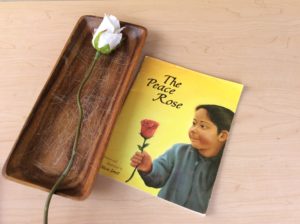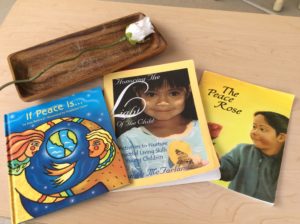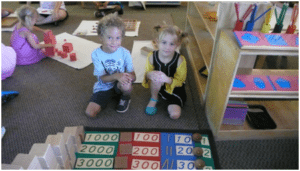Thinking Maps
One of the foundations of a Montessori education at FMS, is the fundamental skill of teaching students how to “organize” their work. It begins the first day in our primary classrooms and continues as a constant theme in every grade thereafter. A key writing tool for organizing thoughts and ideas is the use of the thinking map. A thinking map is a visual tool students are taught to help focus their ideas into a format that makes writing easier.
The entire FMS staff has had two full trainings by Ms. Erica, our Lead Middle School teacher, on the purpose and use of thinking maps. Ms. Erica is certified by the Innovative Learning Group to impart the specifics of using thinking maps. Her enthusiasm and proficiency for using thinking maps conveyed the big picture as to why thinking maps are vital as our “go to” writing tool.
Thinking maps corral scattered and random thoughts in a format that visually represents the desired final effect. It can be as simple as defining a concept, to comparing and contrasting, or sequencing and analyzing cause and effect. Early in this process, Kindergarteners are introduced to the concept of classifying information by using the simplest format, the circle map. They might use the word “colors” in the center and then list all the colors they know in the space around the center circle.
We also learned that drawing a picture of an event in detail helps open the minds of the new writers as they explore the process of defining and describing events in their lives. The more detailed their pictures, the easier it is for them to write sentences. Before they know it, one sentence turns into three as they answer questions such as “When did this happen?”, “Who was involved?”, or “How did you feel about the event?”
According to Innovative Learning Group, “thinking maps are a set of graphic organizer techniques used in primary and secondary education (“K-12”). There are eight diagram types that are intended to correspond with eight different fundamental thinking processes. The eight map types are:
used for defining in context
used for describing with adjectives
used for comparing and contrasting
used for classifying or grouping
used for identifying part/whole relationships
used for sequencing and ordering events
used for analyzing causes and effects
used for illustrating analogies”*
In Thinking with Maps, Elisabeth Camp (2007) investigates how individuals think and how thinking is related to language. Camp (2007) states that “…thinking in maps is substantively different from thinking in sentences” (p. 155). This concept supports Hyerle’s (2011) idea that Thinking Maps possess an artistic and kinesthetic component, where students can feel free to express their ideas in a “drawing,” or map, instead of using complete written sentences. Thinking Maps support learners who thrive with the artistic and kinesthetic multiple intelligences of learning.
Thinking maps are used throughout each of the grades in FMS. The level of detail and fact finding increases as the students move to the older grades, but the fundamental skills of framing their thoughts into a clear and reproducible pattern is taught in the early stages of learning to write.
Our middle school students weighed in on the usefulness of using thinking maps:
By: Sabrina
Of all of the ways we have learned to study, thinking maps have been by far the most helpful. Whenever there is a test coming up and I get ready to study, I always organize my notes into thinking maps. I feel like when I use thinking maps it helps me understand the information better. If there is a whole section on dates – which personally are the hardest things to study for me, I always bring out my thinking maps and use a flow map. It puts the information in order to help me memorize it. Sometimes, I am even able to add multiple maps together to make it MORE easier.
Another reason I love thinking maps is because when we take notes in class it gets stressful sometimes when you have to write down information about a gigantic battle. But, if you use the correct thinking maps you will soon realize that it isn’t stressful at all. What’s also amazing about thinking maps is that they help me in writing class. When we prewrite, I have ideas but it can sometimes be hard for me to organize all of my thoughts, and thinking maps really helps with that.
Thinking maps also are a great way to get me thinking critically. Thinking critically can be extremely hard for some people, but for me I like the challenge. And thinking maps give me the challenges that I need. Also, I have grown up with these maps. I have been going to this school since I was three and every time I would move up a grade we would have a thinking map lesson. This shows me how important and helpful they are. This is why I love thinking maps and can always rely on them.
By: Arianna
I personally like using flow maps and tree maps. A flow map is a map that puts events in chronological order. This map helps me memorize the order of any events for upcoming tests and quizzes. A tree map is a way of listing things in a more organized way than just bullets or sentences. It may seem like a long process at first, but when it comes up to that dreaded test or research paper you have to write, you have already memorized and put your information in a way that by adding a few words can become a great paper or way to study.
By: Caroline
Thinking maps could be used in many different ways, such as brainstorming, prewriting, organizing information, taking notes, and much more! When you have several ideas or thoughts in your head, just create a circle map and write all of them down! If you are about to write an important essay or report, you could use a thinking map to organize your information and prewrite. Thinking maps are also very convenient while taking your notes. They are more brief and easier to read than just listing long notes. Overall, I believe that thinking maps are great visual tools that can help you anywhere and anytime. So, the next time you are taking notes or trying to solve a problem, instead of writing continuously in paragraph form, use a thinking map!
By: Gabriela
I love thinking maps. They are a super fun yet organized way of writing notes, brainstorming, or even sorting things out. I’m so glad that thinking maps are a tool that I learned to use because they have been very helpful to me so far. I use them in many different ways. When I want to compare/contrast two different characters in English, I might use a double-bubble map. Or if I need to make a cause/effect timeline on a battle for history, I would use a multi-flow map. Thinking maps can be used in almost every subject in school. I can organize my thoughts onto a piece of paper, and therefore be more organized and efficient. These charts make my life so much easier, especially when taking notes. It is sometimes easier for me to understand something when it is written down before me. In conclusion, thinking maps are a useful tool that everyone should learn how to use!
By: Jaden
My personal favorite thinking map is the double bubble map because I think it is the most versatile. You can compare and contrast but you can also brainstorm with it. When I am studying the pages that are double bubble maps or any type of maps for that matter, I remember information more clearly when I am studying and when it comes time to the test I can almost perfectly visualize me holding the page whilst studying. That helps me with the pages that I didn’t have a thinking map on because it would spark a memory on the other pages. To be honest, I am not the best on thinking maps, but if I take the time to learn I believe that it will help me out later. For example my brother Brennan is in high school and he still uses thinking maps.
I believe it also helps when two or more people are thinking on what type of thinking map you use and what to put in it. For example, Ms. Erica in the past has had us work and make thinking maps about Upfront articles. Even now, months later, I can vividly remember the thinking maps we did and the article. Thinking Maps truly do wonders and I believe everyone should be educated about them in their life because they can also help not just in school, but life.
Peace Rose
The gift of the yellow rose is a concept that comes out of the Montessori peace curriculum where a silk, yellow rose is used in the classroom much like a talking stick for the students to take turns sharing their feelings and resolving their differences. Dr. Maria Montessori put her educational philosophy forward during the throes of WWI and it remained relevant through the second World War. Part of her drive was to instill the concept that each one of her students had the potential to be a peacemaker. In the classroom today, we carry on her legacy. It is our belief that children in a classroom are no different than people interacting with others in society. There will be stretches of peaceful interactions and then differences of opinions will arise naturally in time. It is natural to feel the full range of emotions from happy to sad, and to feel the frustration of not getting their way. It’s during that time, when we guide the students to verbalize their disappointment and find their voice in an exchange that is respectful and on point.
Dr. Montessori had such respect for the intelligence and latent independence buried in the soul of a child that she was determined to create a learning environment that supported her inspiration. Early on, she shifted the common view that children were undeveloped adults to that each student was an individual child responding to the stimulus of their environment and directly affected by the quality of relationships of the pertinent people in their lives. The power of the Montessori method today is that we collectively are modeling a way of existing in the world. We are sensitive and committed to living the values of respect, trust and honesty. Not only do we offer a pathway for developing intellectual acuity, but the structure and context of interacting with other people is engaged and nurtured daily.
In the classroom today when differences arise, the Montessori teacher is listening very carefully for the child’s perspective and the human tendency to blame others for their discomfort. It is encouraged that a student seek a teacher’s assistance if they feel like they are stuck, and there is little or no response from the other child. However, even then the teacher is there to help facilitate conversation between the children, not to solve the conflict for them. As the children learn to identify their emotions and verbalize their discontent, they learn to see the other child as someone very much like them trying to make their way in the classroom. An inner strength begins to emerge when children experiment with compassion, and open communication. They feel the power of expressing needs and then listening to one another. Conflict resolution arises naturally in an environment where peace is cherished and the power of verbal exchange is experienced successfully.
2015/2016 School year comes to a close.
Transitions are a natural part of life. As we approach the end of our school year the daily routine of going to school will shift into summer vacation time. Summer is a great time to decompress and let the demands of the school year settle, giving children the chance to have unstructured time. Academic skills can be maintained by reading, thinking, and having interesting conversations. It also is a great time to engage children in exploring the world around them. Visiting the library, playing at water parks, and taking early morning walks can give children the time to observe their experiences and put into action all of the communication skills they have developed throughout the school year.
Math can easily be integrated into summer routines as you playfully ask your child to count, to add, or to subtract any combination of objects and things in front of you. Older students are encouraged to reinforce math skills by checking out materials online that deal with place value, fractions and percentages.
Questions for younger children can be framed as “How many forks will we need for dinner? Please set the table?” or “If all of us are going to the water park, how many towels will we need? Please go gather that many towels.”
Early morning is the best time to be outdoors during our hot summers, and it is a great opportunity to sit outside, listen to the birds, watch your pets in the yard, and have that sweet simple time together. Local facilities like Discovery Children’s Museum and Springs Preserve offer good opportunities for outings, and don’t forget that the Las Vegas 51’s play games all summer long.
Our summer break is also a time to slow down our fast pace and take the time for unhurried conversations. A recent NY Times article by Paul Tough (5/22/2016) called To Help Kids Thrive, Coach their Parents states: “The Jamaica experiment helps make the case that if we want to improve children’s opportunities for success, one of the most powerful potential levers for change is not the children themselves, but rather the attitudes, beliefs and behaviors of the adults who surround them. Furthermore, positive influences in children’s early lives can have a profound effect on the development of what are sometimes called non-cognitive skills…a set of emotional and psychological habits and mindsets that enable children to negotiate life effectively inside and outside of school: the ability to understand and follow directions; to focus on a single activity for an extended periods; to interact calmly with other students; to cope with disappointment and persevere through frustration.”
We appreciate the support and dedication that all of our families bring to FMS every day. Together, we create and evolve a community of learners and citizens of the world. Enjoy the summer time!


















